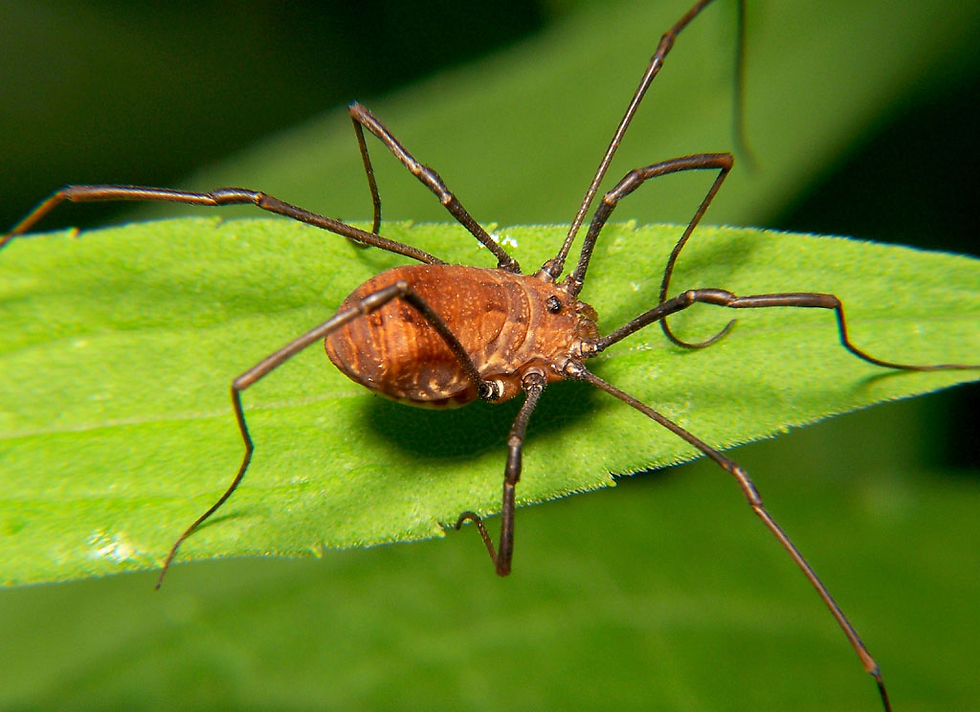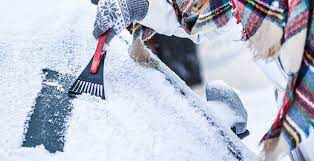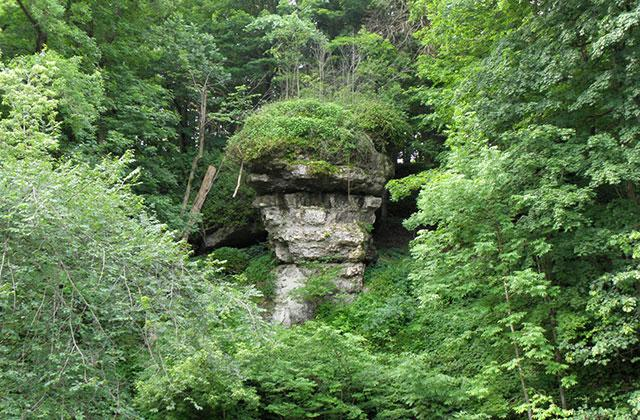Don't get fooled again
- Kenny Slocum

- Apr 5, 2022
- 8 min read
Updated: Apr 8, 2022
I love April. The wildflowers wake up, the horizon on my drive home fills with columns of smoke from prescribed burns, and of course, April fools day. My favorite. Always has been. In fact, I try to keep the spirit of the day in my heart all year round with regular, unwelcome pranks on my wife and deadpan delivery of complete nonsense to my coworkers, all to their chagrin. One of my old staples was changing my birthday on facebook every year, sometimes several times a year, to random dates when I needed a little pick-me-up.
But this month I’d like to fight against my urges, and spend some time looking into a few deep-seated misapprehensions about conservation and the natural world. Let’s take a look at some surprisingly durable myths and see if we can’t all become a little less foolish.
1) Daddy long legs are the most venomous/poisonous spider, but their fangs are too small to bite.
A lot to unpack here. For starters, the name “daddy long legs” often refers to two very different types of arachnids. Harvestmen, in the order Opiliones, are not spiders at all. They only have two eyes, no segmented body plan, and eat decomposing plants and animals. Most importantly, they have no fangs or venom glands at all, getting their meals instead through mouth parts that can grab and chew.

Cellar spiders at least fall under the true spider category. They do have venom, and fangs structured in a manner similar to the brown recluse, and use it to subdue their prey.

We also have to differentiate between venomous and poisonous: poison makes you sick if you bite it, venom makes you sick if it bites you. You can eat a rattlesnake because it’s “only” venomous, but not a toad, because it’s poisonous. However, a toad bite doesn’t do much besides indicate that you’re having a very weird day, while a rattlesnake bite is more of an issue. Harvestmen secrete a poison for defense against predation, but it has no serious toxicity in humans unless consumed by the gallon. Cellar spiders have no such secretions, so we can dismiss the idea of “most poisonous” for either group outright. Now, unless you regularly traffic in playground mythology, you likely don’t believe this one anymore anyway, but there’s actually one more wrinkle: we don’t really know too much about cellar spider venom. It has not received much study for its effects on mammals, save for a few anecdotal reports about mild skin reactions. One study compared the effect of black widow venom to cellar spider venom in mice and found the former had significantly worse outcomes, but for scientific assertions, one study does not provide a very robust data set. 2) Possums eat lots of ticks
I almost hate to go after this one, since the much-persecuted possum could use a little more good PR.

But, it seems the myth that they eat thousands of ticks per season falls short under proper scientific scrutiny. It began with a laboratory study, comparing the ability of several mammals to eradicate an infestation of 100 ticks in their fur. The possums (actually an opossum in North America) did a good job grooming themselves, and those results went on to become extrapolated to the “5,000 ticks per season” statistic.
Field research on wild opossums, however, tells a different story. A 2021 study investigated the stomach contents of 32 wild opossums from central Illinois, and conducted a literature review of 24 peer-reviewed studies on the dietary preference of Didelphis virginiana. Of the 32 opossums studied, none showed any ticks or tick parts in their digestive track. The literature review also showed no evidence of ticks in the opossum food pyramid.

Now, we still have a friend in the wild opossum. Their curious biology features a low body temperature and an immunity to snake venom, meaning they will eat even venomous snakes without fear and many dangerous viruses like Lyme disease and rabies cannot survive in opossums. I’d rather they ate the ticks, but alas, I’ll have to keep tucking my pant legs into my socks. 3) Prairie reconstructions take years to establish because the prairie plants need to grow deep roots first
This one isn’t entirely incorrect. Going from a crop field or cool-season pasture to prairie does usually take a few years before the desirable plants start to make their first appearances. Many people undergoing restorations have marveled at the sudden appearance of certain plants years after the first seeds hit the dirt.
But what you’re waiting on isn’t actually the roots to establish, it’s the soil biology, and many reconstructions fail to match the diversity of remnant, or “reference” prairie because the microbial underpinnings aren’t there - at least not for a long, long time.

Healthy soil, primed to grow anything from prairie forbs to trees, requires the right mixture of fungi, bacteria, and predators like nematodes and microarthropods. When we disrupt the soil biology through tillage or excessive chemical inputs, we generally lose the fungi and predators first. The bacteria, on the other hand, come roaring back in a hurry. They are omnipresent, and reproduce much more rapidly than the other cast of characters that turn dirt into soil.

The waste product of bacteria in the soil increases the amount of nitrogen, creating the perfect conditions nitrophilic plants to thrive. Nitrophilic plants include many of the most common "weeds" to show up in the early phase of prairie restoration like goosefoot or brassicas (garlic mustard and yellow rocket among them). Grasses love high-nitrogen environments too; prairies are naturally pretty nitrogen-rich compared to soils in other habitats like forests, but even in a grassland there can be too much of a good thing.
Until the fungi can return to balance out the soil food web, these plants will dominate, and in the absence of some mechanism, natural or anthropogenic, to reintroduce the fungi and predators, they will continue to dominate. Enter mowing.
The mowing certainly plays a role in the amount of sunlight reaching baby prairie plants, and keeping annual or biennial weeds from seeding but more importantly, it shreds the lignin and cellulose into a medium for decomposing fungi to go to work – provided they can get to the site.
A prairie reconstruction surrounded by sterile soils, or even worse, soils artificially pumped full of N will struggle to achieve good forb diversity for this reason, no matter the seeding rate or mowing regime during the establishment phase. It’s one reason so many reconstructions become dominated by warm-season grasses, especially early in the restoration: it takes a while for the required fungi to show up.

We can get better reconstructions faster with the introduction of beneficial soil fungi and microbes. Some restorations have accomplished this with the application of compost or compost tea, extracted from a diverse array of organic matter to ensure that a diverse suite of fungi can find their way into the soil. Prairie plugs grown in remnant or inoculated soils can also help speed things up, as the friendly fungi go with the plant roots to their new destination.
4) There’s nothing to do in Iowa
Famous potatoes! Go buckeyes! Wait, where is Iowa?
If you read this blog, attend our programs, or visit our parks, this myth likely hasn’t taken root in your psyche. But outside of our borders, many people see Iowa as the ultimate in flyover country. No mountains, no beaches, and just about the worst of all possible worlds in terms of weather. Cold as all get-out in the winter, but usually not enough snow to reliably enjoy winter sports, brutally hot in the summer, tornadoes, derechos… Baby, we got it all, and a lot of it you don’t want.

But that’s just a lack of imagination. I have tried to convince numerous transplants that, to really appreciate Iowa, you have to trade in your trekking poles and powder skis for field guides.
The spring and fall bird migrations are unmatched. Millions of birds, from all over the country, pass through our very doorstep. Massive kettles of raptors dot the blue autumnal sky, and the unmistakable squawk of the sandhill crane echoes through the river valleys in early spring.

I can’t think of too many other places where a person can float something like the yellow river, hooking trout and walleye and bass and catfish in one day on one river. I know there’s nowhere else to see relics from the last ice age like the Pleistocene snail on our talus-algific slopes. Our natural habitats, albeit few and far between, have an outsized biological diversity relative to their size.
Backbone state park, at 1,415 acres, boasts some 680 species among its vascular plant inventory. Yellowstone National Park, at over 2 million acres, including habitats ranging from totally unique hydrothermal environments to semi-arid grasslands at 7,000' to alpine tundra over 11,000' above sea level, counts some 1,350 plants among its denizens.
Read that again. Backbone state park, just over 0.06% the size of one of the world’s most celebrated national parks, with no hot springs or huge elevation changes, has more than half as many flowering plants crammed into its borders - and that's just from one botanical survey, compared to the near-constant presence of resource professionals scouring every nook and cranny of Yellowstone.

If you’re not an ecology nerd, we’re also #1 in the nation for disc golf courses per capita. We’ve got a massive gravel bike scene thanks to our 6th-in-the-nation ranking for gravel road miles. We’ve got places you can rock climb, go caving, paddle, and whitewater kayak - all in one day, if you're truly intrepid.

We’ve got award winning breweries, some of the best whitetail deer hunting in the country (do the second one first), ski resorts, beach resorts, and one of the world’s greatest rivers for all your pleasure boating needs. Our gas stations sell the best pizza in the entire world and I will hear no arguments to the contrary.
Only boring people get bored, and only a fool would think there’s nothing to do here.
Looking Back
March is spring cleaning month. That means cleaning the last of our winter projects from the to-do list, like some timber stand improvements on the Grau savanna at Motor Mill and the reclamation of an old goat prairie, indicated by a population of pasque flower, sideoats gramma, and whorled milkweed dwindling little by little under the shade of encroaching cedar trees.
We've also started readying the parks for the upcoming camping season, an arduous process of cleaning up downed trees, raking gravel from snow removal out of the lawns, getting bathrooms fit for human consu... You know what I'm not gonna say it like that, but you get it.
Meanwhile, the public outreach side of the operation "marched" on, with a few programs geared towards getting people in the mood for exploration.
The always-popular bluebird house workshop took place on March 5th, giving participants new nesting quarters for the bluebirds in search of a good place to raise a family.
On March 19th, runners took their mark for the Motor Motor 5K/10K trail runs. This year we got to see a new course record set on the 5K route, with a time of 21:07 taking first place on the stout, hilly course.

The O.W.L.S. also kicked off their season with a visit to the Earthmoving Legacy Center in Elkader. The museum showcases the long history of excavation and quarrying in Northeast Iowa's hill country, much to the delight of the attendees.
Looking Forward
April means arbor day, and like a millennial's birthday party, we celebrate arbor day for a week here at Clayton County Conservation. We'll be traveling around to county schools to help do an on-site tree planting with local 4th grade classrooms, and the students will bring home their very own tree seedling. If you've got a 4th grader in the home, you might want to scout some good locations! Our thanks to the Iowa DNR for providing the seedlings. On April 27th, the O.W.L.S. will head south to the great river town of LeClaire for a visit to the Buffalo Bill Museum and Antique Archaeology. Call in now to reserve a spot on the shuttle! You won't want to miss the Lonestar steamer, a restored 1800's-era paddle wheel steam boat housed at the Buffalo Bill Museum. On April 28th, Dr. Katherine McCarville from Upper Iowa University will be back to Osborne for "Megafloods and Mighty Rivers," a talk on her intriguing research on the origins of the Iowan Erosion Surface (just west of our own Paleozoic Plateau). With new dating methods and insights from bedrock sampling, Dr. McCarville will offer a new interpretation for the rolling hills of Fayette and Howard counties. Hint: it might have formed a lot faster than you think.




Comments